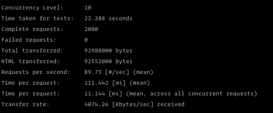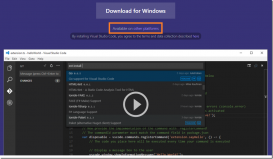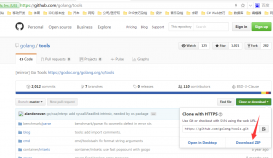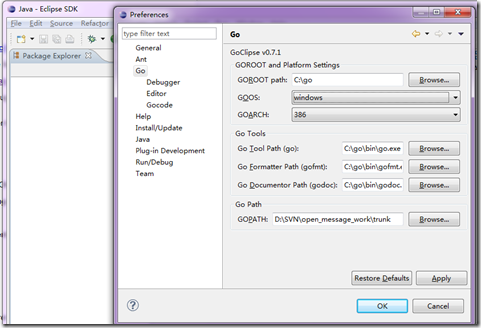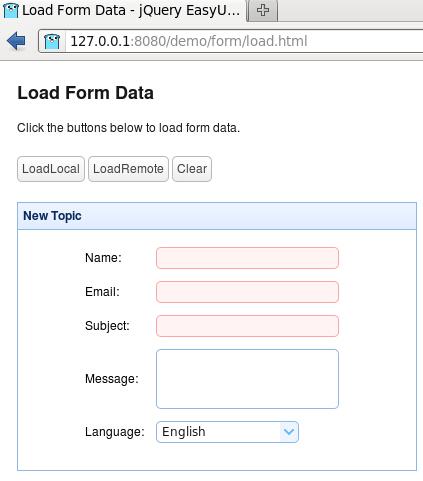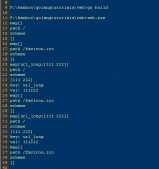前言
对于一名初学者来说,想要尽快熟悉 Go 语言特性,所以以操作式的学习方法为主,比如编写一个简单的数学计算器,读取命令行参数,进行数学运算。
本文讲述使用三种方式讲述 Go 语言如何接受命令行参数,并完成一个简单的数学计算,为演示方便,最后的命令行结果大概是这样的:
|
1
2
3
4
5
6
7
8
9
10
11
12
13
14
|
# input ./calc add 1 2# output3# input./calc sub 1 2# out-1# input./calc mul 10 20# out200 |
使用的三种方式是:
- 内置 os 包读取命令参数
- 内置 flag 包读取命令参数
- cli 框架读取命令参数
0. 已有历史经验
如果你熟悉 Python 、Shell 脚本,你可以比较下:
Python
|
1
2
3
4
5
6
7
|
import sysargs = sys.argv# args 是一个列表# 第一个值表示的是 文件名# 除第一个之外,其他的值是接受的参数 |
Shell
|
1
2
3
4
5
6
7
8
9
10
11
12
|
if [ $# -ne 2 ]; then echo "Usage: $0 param1 pram2" exit 1finame=$1age=$2echo $nameecho $age# `$0` 表示文件名# `$1` 表示第一个参数# `$2` 表示第二个参数 |
能看出一些共性,接收参数,一般解析出来都是一个数组(列表、切片), 第一个元素表示的是文件名,剩余的参数表示接收的参数。
好,那么为了实现 “简单数学计算” 这个功能,读取命令行参数:比如 ./calc add 1 2
除文件名之外的第一个元素:解析为 进行数学运算的 操作,比如: add、sub、mul、sqrt
其余参数表示:进行操作的数值
注意:命令行读取的参数一般为字符串,进行数值计算需要进行数据类型转换
大概思路就是这样。
1. OS 获取命令行参数
|
1
2
3
4
5
6
7
8
9
10
11
12
13
14
15
|
os.Args# 为接受的参数,是一个切片strconv.Atoi # 将字符串数值转换为整型strconv.Itoa# 将整型转换为字符串strconv.ParseFloat# 将字符串数值转换为浮点型 |
|
1
2
3
4
5
6
7
8
9
10
11
12
13
14
15
16
17
18
19
20
21
22
23
24
25
26
27
28
29
30
31
32
33
34
35
36
37
38
39
40
41
42
43
44
45
46
47
48
49
50
51
52
53
54
55
56
57
58
59
60
61
62
63
64
65
66
|
var help = func () { fmt.Println("Usage for calc tool.") fmt.Println("====================================================") fmt.Println("add 1 2, return 3") fmt.Println("sub 1 2, return -1") fmt.Println("mul 1 2, return 2") fmt.Println("sqrt 2, return 1.4142135623730951")}func CalcByOs() error { args := os.Args if len(args) < 3 || args == nil { help() return nil } operate := args[1] switch operate { case "add":{ rt := 0 number_one, err1 := strconv.Atoi(args[2]) number_two, err2 := strconv.Atoi(args[3]) if err1 == nil && err2 == nil { rt = number_one + number_two fmt.Println("Result ", rt) } } case "sub": { rt := 0 number_one, err1 := strconv.Atoi(args[2]) number_two, err2 := strconv.Atoi(args[3]) if err1 == nil && err2 == nil { rt += number_one - number_two fmt.Println("Result ", rt) } } case "mul": { rt := 1 number_one, err1 := strconv.Atoi(args[2]) number_two, err2 := strconv.Atoi(args[3]) if err1 == nil && err2 == nil { rt = number_one * number_two fmt.Println("Result ", rt) } } case "sqrt": { rt := float64(0) if len(args) != 3 { fmt.Println("Usage: sqrt 2, return 1.4142135623730951") return nil } number_one, err := strconv.ParseFloat(args[2], 64) if err == nil { rt = math.Sqrt(number_one) fmt.Println("Result ", rt) } } default: help() } return nil} |
最后的效果大概是:
|
1
2
3
4
5
6
7
8
9
10
11
12
13
14
15
16
17
|
./calc add 1 2Result 3====================./calc sub 1 2Result -1====================./calc mul 10 20Result 200===================./calc sqrt 2Result 1.4142135623730951 |
2. flag 获取命令行参数
flag 包比 os 读取参数更方便。可以自定义传入的参数的类型:比如字符串,整型,浮点型,默认参数设置等
基本的使用方法如下:
|
1
2
3
|
var operate stringflag.StringVar(&operate,"o", "add", "operation for calc") |
# 解释
绑定 operate 变量, name="o", value="add" , usage="operation for calc"
也可以这样定义为指针变量
|
1
|
var operate := flag.String("o", "add", "operation for calc") |
同时还可以自定义 flag 类型
所有变量注册之后,调用 flag.Parse() 来解析命令行参数, 如果是绑定变量的方式,直接使用变量进行操作,
如果使用指针变量型,需要 *operate 这样使用。
flag.Args() 表示接收的所有命令行参数集, 也是一个切片
|
1
2
3
|
for index, value := range flag.Args { fmt.Println(index, value)} |
|
1
2
3
4
5
6
7
8
9
10
11
12
13
14
15
16
17
18
19
20
21
22
23
24
25
26
|
func CalcByFlag() error { var operation string var numberone float64 var numbertwo float64 flag.StringVar(&operation, "o", "add", "operation for this tool") flag.Float64Var(&numberone, "n1", 0, "The first number") flag.Float64Var(&numbertwo, "n2", 0, "The second number") flag.Parse() fmt.Println(numberone, numbertwo) if operation == "add" { rt := numberone + numbertwo fmt.Println("Result ", rt) } else if operation == "sub" { rt := numberone - numbertwo fmt.Println("Result ", rt) } else if operation == "mul" { rt := numberone * numbertwo fmt.Println("Result ", rt) } else if operation == "sqrt" { rt := math.Sqrt(numberone) fmt.Println("Result ", rt) } else { help() } return nil} |
最后的结果效果如下:
|
1
2
3
4
5
6
7
8
9
10
11
12
13
14
15
16
17
|
./calc -o add -n1 1 -n2 2Result 3=============================./calc -o sub -n1 2 -n2 3Result -1============================./calc -o mul -n1 10 -n2 20Result 200===========================./calc -o sqrt -n1 2Result 1.4142135623730951 |
3. CLI 框架
cli 是一款业界比较流行的命令行框架。
所以你首先需要安装:
|
1
|
go get github.com/urfave/cli |
|
1
2
3
4
5
6
7
8
9
10
11
12
13
14
15
16
17
18
19
20
21
|
# 一个简单的示例如下:package mainimport ( "fmt" "os" "github.com/urfave/cli")func main() { app := cli.NewApp() app.Name = "boom" app.Usage = "make an explosive entrance" app.Action = func(c *cli.Context) error { fmt.Println("boom! I say!") return nil } app.Run(os.Args)} |
好,为实现 “简单数学计算” 的功能,我们应该怎么实现呢?
主要是 使用 框架中的 Flag 功能,对参数进行设置
|
1
2
3
4
5
6
7
8
9
10
11
12
13
14
15
16
17
|
app.Flags = []cli.Flag { cli.StringFlag{ Name: "operation, o", Value: "add", Usage: "calc operation", }, cli.Float64Flag{ Name: "numberone, n1", Value: 0, Usage: "number one for operation", }, cli.Float64Flag{ Name: "numbertwo, n2", Value: 0, Usage: "number two for operation", },} |
能看出,我们使用了三个参数:operation、numberone、numbertwo
同时定义了参数的类型,默认值,以及别名(缩写)
那么在这个框架中如何实现参数的操作呢:主要是重写app.Action 方法
|
1
2
3
4
5
6
7
8
9
10
11
12
13
14
15
16
17
18
19
20
21
22
23
24
|
app.Action = func(c *cli.Context) error { operation := c.String("operation") numberone := c.Float64("numberone") numbertwo := c.Float64("numbertwo") //fmt.Println(operation, numberone, numbertwo) if operation == "add" { rt := numberone + numbertwo fmt.Println("Result ", rt) } else if operation == "sub" { rt := numberone - numbertwo fmt.Println("Result ", rt) } else if operation == "mul" { rt := numberone * numbertwo fmt.Println("Result ", rt) } else if operation == "sqrt" { rt := math.Sqrt(numberone) fmt.Println("Result ", rt) } else { help() } return nil}# 对 operation 参数进行判断,执行的是那种运算,然后编写相应的运算操作 |
|
1
2
3
4
5
6
7
8
9
10
11
12
13
14
15
16
17
18
19
20
21
22
23
24
25
26
27
28
29
30
31
32
33
34
35
36
37
38
39
40
41
42
43
44
45
46
|
func CalcByCli(){ app := cli.NewApp() app.Name = "calc with go" app.Usage = "calc tool operate by go" app.Version = "0.1.0" app.Flags = [] cli.Flag { cli.StringFlag{ Name: "operation, o", Value: "add", Usage: "calc operation", }, cli.Float64Flag{ Name: "numberone, n1", Value: 0, Usage: "number one for operation", }, cli.Float64Flag{ Name: "numbertwo, n2", Value: 0, Usage: "number two for operation", }, } app.Action = func(c *cli.Context) error { operation := c.String("operation") numberone := c.Float64("numberone") numbertwo := c.Float64("numbertwo") //fmt.Println(operation, numberone, numbertwo) if operation == "add" { rt := numberone + numbertwo fmt.Println("Result ", rt) } else if operation == "sub" { rt := numberone - numbertwo fmt.Println("Result ", rt) } else if operation == "mul" { rt := numberone * numbertwo fmt.Println("Result ", rt) } else if operation == "sqrt" { rt := math.Sqrt(numberone) fmt.Println("Result ", rt) } else { help() } return nil } app.Run(os.Args)} |
调用这个函数的最终效果如下:
|
1
2
3
4
5
6
7
8
9
10
11
12
13
14
15
16
17
|
./calc -o add --n1 12 --n2 12Result 24===================================./calc -o sub --n1 100 --n2 200Result -100===================================./calc -o mul --n1 10 --n2 20Result 200===================================./calc -o sqrt --n1 2Result 1.4142135623730951 |
4 其他
知道如何读取命令行参数,就可以实现一些更有意思的事。
比如网上有许多免费的 API 接口,比如查询天气,查询农历的API 接口。
还有一些查询接口,比如有道云翻译接口,你可以实现翻译的功能。
或者扇贝的接口,实现查询单词的功能。
再比如一些音乐接口,实现音乐信息查询。
不一一列了。
下面实现一个调用免费的查询天气的接口实现命令行查询天气。
GO 如何进行 HTTP 访问?内置的 net/http 可以实现
一个简易的GET 操作如下:
|
1
2
3
4
5
6
7
8
9
|
func Requests(url string) (string, error) { response, err := http.Get(url) if err != nil { return "", err } defer response.Body.Close() body, _ := ioutil.ReadAll(response.Body) return string(body), nil} |
免费的 API URL 如下:
|
1
|
http://www.sojson.com/open/api/weather/json.shtml?city=北京 |
返回的结果是一个Json 格式的数据
|
1
2
3
4
5
6
7
8
9
10
11
12
13
14
15
16
17
18
19
20
21
22
23
24
25
26
27
28
29
30
31
32
33
34
35
36
37
38
39
40
41
42
43
44
45
46
47
48
49
50
51
52
53
54
55
56
57
58
59
60
|
{ "status": 200, "data": { "wendu": "29", "ganmao": "各项气象条件适宜,发生感冒机率较低。但请避免长期处于空调房间中,以防感冒。", "forecast": [ { "fengxiang": "南风", "fengli": "3-4级", "high": "高温 32℃", "type": "多云", "low": "低温 17℃", "date": "16日星期二" }, { "fengxiang": "南风", "fengli": "微风级", "high": "高温 34℃", "type": "晴", "low": "低温 19℃", "date": "17日星期三" }, { "fengxiang": "南风", "fengli": "微风级", "high": "高温 35℃", "type": "晴", "low": "低温 22℃", "date": "18日星期四" }, { "fengxiang": "南风", "fengli": "微风级", "high": "高温 35℃", "type": "多云", "low": "低温 22℃", "date": "19日星期五" }, { "fengxiang": "南风", "fengli": "3-4级", "high": "高温 34℃", "type": "晴", "low": "低温 21℃", "date": "20日星期六" } ], "yesterday": { "fl": "微风", "fx": "南风", "high": "高温 28℃", "type": "晴", "low": "低温 15℃", "date": "15日星期一" }, "aqi": "72", "city": "北京" }, "message": "OK"} |
所以我们的任务就是传入 “城市” 的名称,再对返回的 Json 数据解析。
|
1
2
3
4
5
6
7
8
9
10
11
12
13
14
15
16
17
18
19
20
21
22
23
24
25
26
27
28
29
30
31
32
33
34
35
36
37
38
39
40
41
42
43
44
45
46
47
48
49
50
51
52
53
54
55
56
57
58
59
60
61
62
63
64
65
66
67
68
69
70
71
72
73
74
75
76
77
78
79
80
81
82
83
84
85
86
87
88
89
90
91
92
93
94
95
96
97
98
99
100
101
102
103
104
105
106
107
108
109
110
111
112
113
114
115
116
117
118
119
120
121
122
123
124
125
126
127
128
129
|
package mainimport ( "fmt" "os" "encoding/json" "github.com/urfave/cli" "net/http" "io/ioutil" //"github.com/modood/table")type Response struct { Status int `json:"status"` CityName string `json:"city"` Data Data `json:"data"` Date string `json:"date"` Message string `json:"message"` Count int `json:"count"`}type Data struct { ShiDu string `json:"shidu"` Quality string `json:"quality"` Ganmao string `json:"ganmao"` Yesterday Day `json:"yesterday"` Forecast []Day `json:"forecast"`}type Day struct { Date string `json:"date"` Sunrise string `json:"sunrise"` High string `json:"high"` Low string `json:"low"` Sunset string `json:"sunset"` Aqi float32 `json:"aqi"` Fx string `json:"fx"` Fl string `json:"fl"` Type string `json:"type"` Notice string `json:"notice"`}func main() { const apiURL = "http://www.sojson.com/open/api/weather/json.shtml?city=" app := cli.NewApp() app.Name = "weather-cli" app.Usage = "天气预报小程序" app.Flags = []cli.Flag{ cli.StringFlag{ Name: "city, c", Value: "上海", Usage: "城市中文名", }, cli.StringFlag{ Name: "day, d", Value: "今天", Usage: "可选: 今天, 昨天, 预测", }, cli.StringFlag{ Name: "Author, r", Value: "xiewei", Usage: "Author name", }, } app.Action = func(c *cli.Context) error { city := c.String("city") day := c.String("day") var body, err = Requests(apiURL + city) if err != nil { fmt.Printf("err was %v", err) return nil } var r Response err = json.Unmarshal([]byte(body), &r) if err != nil { fmt.Printf("\nError message: %v", err) return nil } if r.Status != 200 { fmt.Printf("获取天气API出现错误, %s", r.Message) return nil } Print(day, r) return nil } app.Run(os.Args)}func Print(day string, r Response) { fmt.Println("城市:", r.CityName) if day == "今天" { fmt.Println("湿度:", r.Data.ShiDu) fmt.Println("空气质量:", r.Data.Quality) fmt.Println("温馨提示:", r.Data.Ganmao) } else if day == "昨天" { fmt.Println("日期:", r.Data.Yesterday.Date) fmt.Println("温度:", r.Data.Yesterday.Low, r.Data.Yesterday.High) fmt.Println("风量:", r.Data.Yesterday.Fx, r.Data.Yesterday.Fl) fmt.Println("天气:", r.Data.Yesterday.Type) fmt.Println("温馨提示:", r.Data.Yesterday.Notice) } else if day == "预测" { fmt.Println("====================================") for _, item := range r.Data.Forecast { fmt.Println("日期:", item.Date) fmt.Println("温度:", item.Low, item.High) fmt.Println("风量:", item.Fx, item.Fl) fmt.Println("天气:", item.Type) fmt.Println("温馨提示:", item.Notice) fmt.Println("====================================") } } else { fmt.Println("...") }}func Requests(url string) (string, error) { response, err := http.Get(url) if err != nil { return "", err } defer response.Body.Close() body, _ := ioutil.ReadAll(response.Body) return string(body), nil} |
最终的效果大概如下:
|
1
2
3
4
5
6
7
8
9
10
11
12
13
14
15
16
17
|
./weather -c 上海城市: 上海湿度: 80%空气质量: 轻度污染温馨提示: 儿童、老年人及心脏、呼吸系统疾病患者人群应减少长时间或高强度户外锻炼================================./weaather -c 上海 -d 昨天城市: 上海日期: 28日星期二温度: 低温 12.0℃ 高温 19.0℃风量: 西南风 <3级天气: 小雨温馨提示: 雾蒙蒙的雨天,最喜欢一个人听音乐 |
总结
以上就是这篇文章的全部内容了,希望本文的内容对大家的学习或者工作具有一定的参考学习价值,如果有疑问大家可以留言交流,谢谢大家对服务器之家的支持。
原文链接:http://www.jianshu.com/p/548adff0d10d



